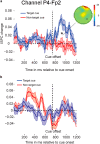Competitive Frontoparietal Interactions Mediate Implicit Inferences
- PMID: 31015338
- PMCID: PMC6595957
- DOI: 10.1523/JNEUROSCI.2551-18.2019
Competitive Frontoparietal Interactions Mediate Implicit Inferences
Abstract
Frequent experience with regularities in our environment allows us to use predictive information to guide our decision process. However, contingencies in our environment are not always explicitly present and sometimes need to be inferred. Heretofore, it remained unknown how predictive information guides decision-making when explicit knowledge is absent and how the brain shapes such implicit inferences. In the present experiment, 17 human participants (9 females) performed a discrimination task in which a target stimulus was preceded by a predictive cue. Critically, participants had no explicit knowledge that some of the cues signaled an upcoming target, allowing us to investigate how implicit inferences emerge and guide decision-making. Despite unawareness of the cue-target contingencies, participants were able to use implicit information to improve performance. Concurrent EEG recordings demonstrate that implicit inferences rely upon interactions between internally and externally oriented networks, whereby prefrontal regions inhibit parietal cortex under internal implicit control.SIGNIFICANCE STATEMENT Regularities in our environment can guide our behavior providing information about upcoming events. Interestingly, such predictive information does not need to be explicitly represented to effectively guide our decision process. Here, we show how the brain engages in such real-world "data mining" and how implicit inferences emerge. We used a contingency cueing task and demonstrated that implicit inferences influenced responses to subsequent targets despite a lack of awareness of cue-target contingencies. Further, we show that these implicit inferences emerge through interactions between internally and externally oriented neural networks. The current results highlight the importance of prefrontal processes in transforming external events into predictive internalized models of the world.
Keywords: EEG; consciousness; decision-making; inferences; neural networks dynamics; prefrontal cortex.
Copyright © 2019 the authors.
Figures







Similar articles
-
Theta Signal Transfer from Parietal to Prefrontal Cortex Ignites Conscious Awareness of Implicit Knowledge during Sequence Learning.J Neurosci. 2023 Oct 4;43(40):6760-6778. doi: 10.1523/JNEUROSCI.2172-22.2023. Epub 2023 Aug 22. J Neurosci. 2023. PMID: 37607820 Free PMC article.
-
Categorical implicit learning in real-world scenes: evidence from contextual cueing.Q J Exp Psychol (Hove). 2011 May;64(5):920-41. doi: 10.1080/17470218.2010.526231. Epub 2010 Dec 15. Q J Exp Psychol (Hove). 2011. PMID: 21161855
-
Implicit visual cues tune oscillatory motor activity during decision-making.Neuroimage. 2019 Feb 1;186:424-436. doi: 10.1016/j.neuroimage.2018.11.027. Epub 2018 Nov 17. Neuroimage. 2019. PMID: 30458303
-
Expectations and outcomes: decision-making in the primate brain.J Comp Physiol A Neuroethol Sens Neural Behav Physiol. 2005 Mar;191(3):201-11. doi: 10.1007/s00359-004-0565-9. Epub 2004 Oct 12. J Comp Physiol A Neuroethol Sens Neural Behav Physiol. 2005. PMID: 15759141 Review.
-
Implicit and explicit social mentalizing: dual processes driven by a shared neural network.Front Hum Neurosci. 2013 Sep 13;7:560. doi: 10.3389/fnhum.2013.00560. Front Hum Neurosci. 2013. PMID: 24062663 Free PMC article. Review.
Cited by
-
Action information contributes to metacognitive decision-making.Sci Rep. 2020 Feb 27;10(1):3632. doi: 10.1038/s41598-020-60382-y. Sci Rep. 2020. PMID: 32107455 Free PMC article.
-
The Set of Priors Related Concepts Instrumental in Understanding Conscious Perception Begs Clarification.Front Psychol. 2020 Jun 23;11:1293. doi: 10.3389/fpsyg.2020.01293. eCollection 2020. Front Psychol. 2020. PMID: 32655453 Free PMC article. No abstract available.
-
Frontopolar theta oscillations link metacognition with prospective decision making.Nat Commun. 2021 Jun 24;12(1):3943. doi: 10.1038/s41467-021-24197-3. Nat Commun. 2021. PMID: 34168135 Free PMC article.
References
Publication types
MeSH terms
LinkOut - more resources
Full Text Sources
